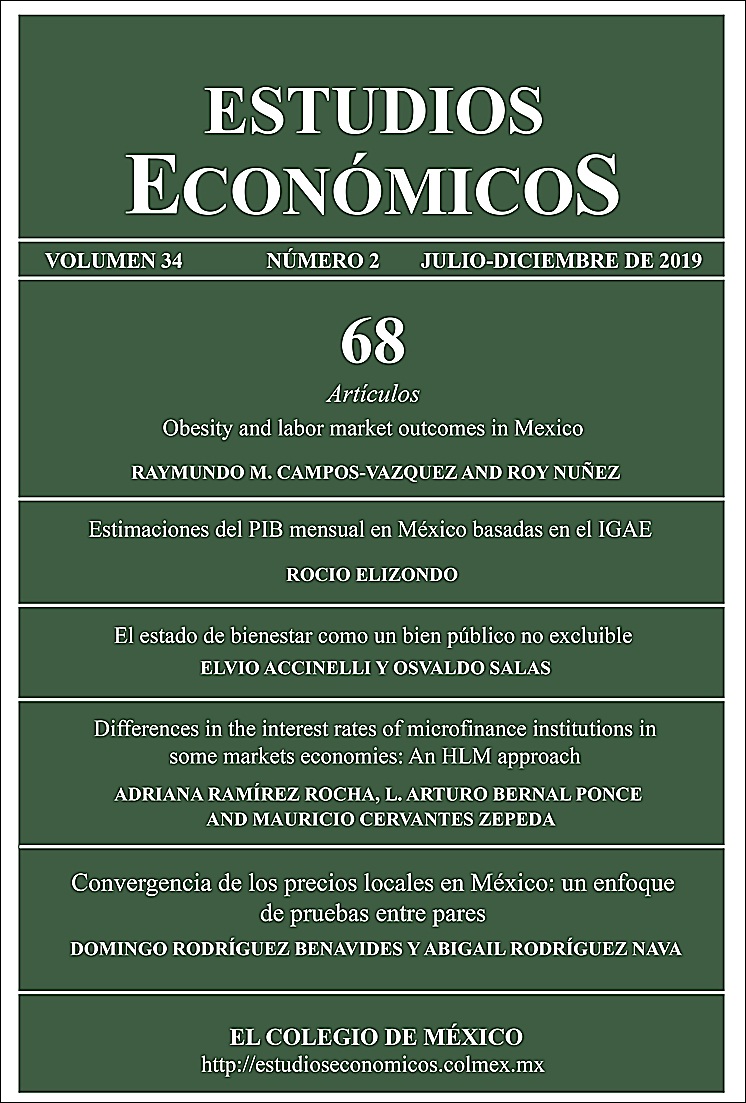Publicado 2019-07-01
Palabras clave
- producto interno bruto,
- indicador global de la actividad económica (IGAE),
- filtro de kalman,
- método de denton,
- pronósticos
Cómo citar
Resumen
Se presentan tres métodos para estimar el PIB mensual en México: (1) una aproximación determinística; (2) una extensión del método de Denton; y, (3) el filtro de Kalman. En dichos métodos el PIB mensual es una variable no observable que se aproxima utilizando únicamente al IGAE. Los tres métodos muestran un buen ajuste a los datos observados del PIB trimestral dentro de la muestra, con errores promedio de ajuste como máximo de 0.1%. Adicionalmente, dada la estructura dinámica del método de filtro de Kalman y que sus parámetros permanecen relativamente estables bajo diferentes periodos de estimación, se utilizó este para realizar pronósticos fuera de la muestra.
Descargas
Citas
- Chow, G.C. y A. Lin. 1971. Best Linear Unbiased Interpolation, Distribution, and Extrapolation of Time Series by Related Series, The Review of Economics and Statistics, 53(4): 372-375.
- Cortázar, G., E. Schwartz y L. Naranjo. 2003. Term Structure Estimation in Low-Frequency Transaction Markets: A Kalman Filter Approach with Incomplete Panel-Data, UC Los Angeles: Anderson Graduate School of Management, recuperado de: http:// escholarship.org/uc/ítem/56h775cz.
- Cuche, N.A. y M.K. Hess. 2000. Estimating Monthly GDP in a General Kalman Filter Framework: Evidence from Switzerland, Economic and Financial Modeling, pp. 153-193.
- De Alba, E. 1990. Estimación del PIB trimestral para México, Estudios Económicos, 5(2): 359-370.
- Denton, F.T. 1971. Adjustment of Monthly or Quarterly Series to Annual Totals: An Approach Based on Quadratic Minimization, Journal of the American Statistical Association, 66 (333): 99-102.
- Fernández, R.B. 1981. A Methodological Note on the Estimation of Time Series, The Review of Economics and Statistics, 63(3): 471-476.
- Guerrero, V. M. 1990. Temporal Disaggregation of Time Series: An ARIMA based approach, International Statistical Review, 58: 29-46.
- Guerrero, V. M. 2003. Monthly Disaggregation of a Quarterly Time Series and Forecast of Its Unobservable Monthly Values, Journal of Official Statistics, 19(3): 215-235.
- Guerrero, V. M. 2004. Nota sobre la estimación del PIB mensual de México, Estadística, 56(166): 35-60.
- Guerrero, V. M. y J. Martínez. 1995. A Recursive ARIMA-Based Procedure For Disaggre-gating a Time Series Variable Using Concurrent Data, Test, 4(2): 359-376.
- Harvey, A.C. y N. Shephard. 1993. Structural Time Series Models, en G.S. Maddala, C.R. Rao y H.D. Vinod (eds.) Handbook of Statistics, vol. 11, pp. 261-302.
- Karanfil, F y A. Ozkaya. 2007. Estimation of Real GDP and Unrecorded Economy in Turkey Base Done Environmental Data, Energy Policy, 35(10): 4902-4908.
- Kleinbauer, R. 2004. Kalman Filtering Implementation with Matlab, Study Report in the Field of Study Geodesy and Geoinformatics at University Stuttgart.
- Mariano, R.S. y Y. Murasawa. 2000. A New Coincident Index of Business Cycles Base on Monthly and Quarterly Series, Journal of Applied Econometrics, 18: 427-443.
- Pasricha, G.K. 2006. Kalman Filter and its Economic Applications, MPRA Paper, núm. 22734.
- Solera, A. 2003. El Filtro de Kalman, Nota Técnica No. DIE-02-2003-NT del Banco Central de Costa Rica.
- Stock, J. H. y M. W. Watson. 1998. A probability Model of the Coincident Economic Indicators, NBER Working Paper Series, núm. 2772.
- Stock, J. H. y M. W. Watson. 2002. Macroeconomic Forecasting Using Diffusion Indexes, Journal of Business and Economic Statistics, 20(2): 147-162.
- Tanizaki, H. 1996. State-Space Model in Linear Case, Nonlinear Filters: Estimation and Applications, Springer-Verlarg, capítulo 1, pp.15-41.
- Welch, G. y G. Bishop. 2006. An Introduction to the Kalman Filter, Department of Computer Science, University of North Carolina at Chapel Hill.
- Wu, K.H. y Z.G. Chen. 2006. Comparison of Benchmarking Methods with and Without Survey Error Model, International Statistical Review, 74(3): 285-304.

